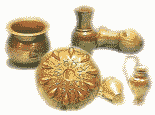The historical background of Usak goes back to 5000 BC. The province is situated at the inner side of Western Anatolia. Being closer to the central region, rather than the Aegean, a typical continental climate prevails in the area. The most distinct characteristic of the city is its location, constituting a pathway between four different regions of Turkey, namely the Marmara, Aegean, Central Anatolian and the Mediterranean regions.
 As such a binding point, the province witnessed the earliest civilizations which have passed by, and left their signs in every corner of the land. From the Lydians to the Persians, from the Romans to the Ottomans, Usak had been ruled by many invaders and settlers, and the remains of those ancient times are found in various districts. There is a great archaeological museum in the province, which holds the finds from the area and is worth a visit for those who are interested. Especially the display of Karun Treasures who were stolen during illegal excavations in the 60's and which were returned back in 1993 by the Authorities in collaboration of Metropolitan Museum of Art, are the best examples of the museum.
As such a binding point, the province witnessed the earliest civilizations which have passed by, and left their signs in every corner of the land. From the Lydians to the Persians, from the Romans to the Ottomans, Usak had been ruled by many invaders and settlers, and the remains of those ancient times are found in various districts. There is a great archaeological museum in the province, which holds the finds from the area and is worth a visit for those who are interested. Especially the display of Karun Treasures who were stolen during illegal excavations in the 60's and which were returned back in 1993 by the Authorities in collaboration of Metropolitan Museum of Art, are the best examples of the museum.
One of the interesting ancient sites in Usak is Blaundus from 4th century BC. It's located at Sulumenli village, around 40 km (25 miles) from the city center.
Usak is an important and lively weaving center. High quality cotton cloth and bed sheets are widely produced in the various towns; and the carpets and kilims traditionally woven here are world famous, with their many colors and beautiful motifs. There are also picnicking areas and thermal centers in the region.
Esme Kilims
 Although antique carpets are world famous, today the province's weavers make kilims instead of carpets. Kilims are associated first and foremost with the district of Esme and the village of Takmak. The women of Takmak do not make kilims commercially, but only for the dowries of their daughters or grandchildren. Esme on the other hand has turned kilim weaving into a commercial asset, and has held a kilim festival every May. The sixty villages of the district are all cashing in on the growing popularity of kilims, and thanks to the efforts of some entrepreneurs traditional colors and designs have been revived. Over recent years kilim weaving has come to rival tobacco cultivation as the main source of income for local families. There are many different local types of kilim design, such as the safe namazlik, selvili namazlik, altinbas, albas, aynali kilim, and Takmak kilimi. The kilims woven in the area are sold first to wholesalers in Istanbul, and from there are exported all over the world.
Although antique carpets are world famous, today the province's weavers make kilims instead of carpets. Kilims are associated first and foremost with the district of Esme and the village of Takmak. The women of Takmak do not make kilims commercially, but only for the dowries of their daughters or grandchildren. Esme on the other hand has turned kilim weaving into a commercial asset, and has held a kilim festival every May. The sixty villages of the district are all cashing in on the growing popularity of kilims, and thanks to the efforts of some entrepreneurs traditional colors and designs have been revived. Over recent years kilim weaving has come to rival tobacco cultivation as the main source of income for local families. There are many different local types of kilim design, such as the safe namazlik, selvili namazlik, altinbas, albas, aynali kilim, and Takmak kilimi. The kilims woven in the area are sold first to wholesalers in Istanbul, and from there are exported all over the world.

